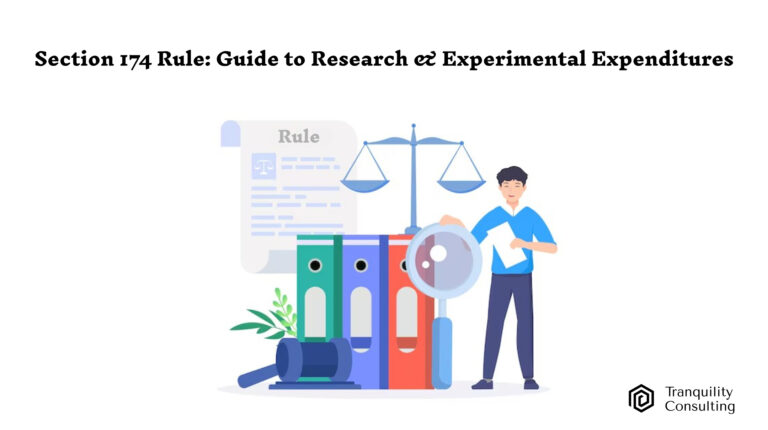The Section 174 Rule under U.S. tax law significantly impacts businesses, particularly those engaged in research and development (R&D). The rule mandates the capitalization and amortization of research and experimental (R&E) expenses over a specific period. This change, enacted as part of the Tax Cuts and Jobs Act (TCJA), has reshaped how companies approach tax planning and R&D expenditures. For businesses, especially non-U.S. residents involved in significant R&D activities, understanding the nuances of this rule is essential for maintaining compliance and optimizing cash flow.
What is Section 174?
Section 174 of the U.S. Internal Revenue Code (IRC) governs how businesses treat Research and experimental (R&E) Expenses for tax purposes. Historically, companies were allowed to deduct R&E expenses in the year they were incurred, providing immediate tax relief. However, beginning in 2022, the Tax Cuts and Jobs Act (TCJA) has required companies to capitalize and amortize these expenditures over a fixed period.
Under the Section 174 Rule, the amortization period is:
- 5 years for U.S.-based R&E expenditures.
- 15 years for foreign-based R&E expenditures.
This adjustment means that companies can no longer receive immediate deductions for R&D costs, directly impacting cash flow and tax planning strategies.
Why the Section 174 Rule Matters
The new Section 174 Rule is crucial for businesses that heavily invest in research and development. Immediate deductions provided much-needed liquidity, particularly for startups and innovation-focused companies. By moving to a capitalization and amortization system, businesses must now spread their R&E expenses over a more extended period, which alters the timing of tax benefits and, potentially, the ability to invest further in R&D.
Key Implications:
- Impact on Cash Flow: Previously, businesses could deduct R&D costs upfront, reducing taxable income and taxes due. With the shift to amortization, the upfront deduction disappears, and tax benefits are delayed, which can strain cash flow.
- Tax Planning Adjustments: Companies must adjust their tax planning strategies to account for the new rules. Taxpayers may need to reassess their tax liabilities and future projections, mainly if they rely heavily on R&E activities.
- Compliance Obligations: Under the new rules, businesses must adequately account for their R&D expenses. The Internal Revenue Service (IRS) expects precise tracking and reporting of domestic versus foreign R&E expenditures, as different amortization periods apply.
Section 174 and Non-U.S. Resident Businesses
Understanding the implications of Section 174 is particularly important for non-U.S. resident companies conducting research in the U.S. or involved in global R&D operations. These companies must also capitalize and amortize R&E expenses under U.S. tax law, which may differ from the treatment of R&D expenses in their home countries.
Domestic vs Foreign R&E Expenses
One of the significant aspects of the Section 174 Rule is the distinction between domestic and foreign R&E expenditures. U.S.-based R&E costs are amortized over 5 years, while foreign R&E expenditures must be amortized over fifteen years. This extended amortization period for foreign expenditures can complicate the financial picture for multinational companies, as they face longer delays before realizing tax benefits from foreign R&D activities.
This distinction between domestic and foreign R&D expenses creates added layers of complexity for non-U.S. businesses. Proper tax planning is critical to mitigate the financial impact of Section 174 and ensure that R&D activities are structured in the most tax-efficient manner possible.
Steps for Compliance with Section 174
- Tracking R&D Expenses: Businesses must carefully track and categorize their R&D expenses between domestic and foreign activities. Proper tracking is essential, given the different amortization periods.
- Amortization Schedules: Companies should establish and maintain accurate amortization schedules for their R&D expenses, ensuring compliance with Section 174. This includes spreading the deductions over the appropriate time frame, depending on whether the R&D activities are U.S.-based or foreign.
- Tax Strategy Updates: Businesses should revisit their overall tax strategy to account for the delayed benefits of R&D deductions. This may involve optimizing other business areas to balance the cash flow impact of the Section 174 Rule.
- Consulting with Tax Professionals: Given the complexity of the Section 174 Rule, companies should work with tax advisors or specialists to ensure full compliance and minimize any unintended financial consequences.
Opportunities for Non-U.S. Resident Businesses
While the Section 174 Rule presents challenges, there are opportunities for non-U.S. resident businesses to optimize their R&D investments and tax planning.
R&D Tax Credits
Although businesses must amortize their R&D expenses under Section 174, they may still be eligible for R&D tax credits. These credits can offset the cost of R&D investments, providing additional financial relief to businesses engaged in innovation. Companies that qualify for these credits should factor them into their overall tax planning strategy.
Structuring Global R&D Operations
Businesses can explore ways to structure their global R&D operations to optimize tax benefits. For example, companies with substantial R&D activities abroad may want to consider whether shifting more R&D efforts domestically makes financial sense to take advantage of the shorter amortization period for U.S.-based expenditures.
This requires a deep understanding of the U.S. tax system and the tax rules in the company’s home country. A comprehensive approach can help businesses make informed decisions about where to locate their R&D efforts for the most significant tax benefits.
The Future of Section 174
Many companies are advocating for changes to the Section 174 Rule, seeking to revert to the pre-TCJA system that allowed for immediate deductions of R&D expenses. However, unless legislative changes are made, businesses must prepare for the long-term impact of this rule.
The move to capitalize and amortize R&E expenses is likely to remain a significant consideration for companies engaged in innovation, particularly as they look to balance tax efficiency with ongoing investment in research and development.
Conclusion
The Section 174 Rule represents a significant shift in how businesses treat R&E expenses. The rule has changed the tax landscape for companies involved in research and development by requiring the capitalization and amortization of these expenses over time. Given the distinction between domestic and foreign R&D expenditures, non-U.S. resident businesses must be especially mindful of these changes. Effective tax planning and compliance are essential for navigating the complexities of the Section 174 Rule. By carefully tracking R&E expenditures, establishing accurate amortization schedules, and exploring opportunities such as R&D tax credits, businesses can mitigate the financial impact and continue to innovate.
FAQs
- What is Section 174?
Section 174 of the U.S. IRC requires businesses to capitalize and amortize R&D expenses over 5 years for domestic and 15 years for foreign expenditures.
- How does Section 174 affect businesses?
Businesses can no longer immediately deduct R&D expenses. Instead, they must amortize them, impacting cash flow and tax planning.
- Can non-U.S. businesses benefit from Section 174?
Yes, non-U.S. businesses conducting research in the U.S. or abroad must also comply with Section 174, though they face a longer amortization period for foreign R&D.
- What is the difference between domestic and foreign R&E expenditures under Section 174?
Domestic R&E expenses are amortized over 5 years, while foreign R&E expenditures must be amortized over 15 years.
- How can Tranquility Consulting help with Section 174 compliance?
Tranquility Consulting offers expert tax guidance, helping businesses track, capitalize, and amortize R&D expenses while optimizing their tax strategy.
If you have any questions or need business-related tax consulting advice, please contact us at: [email protected]





